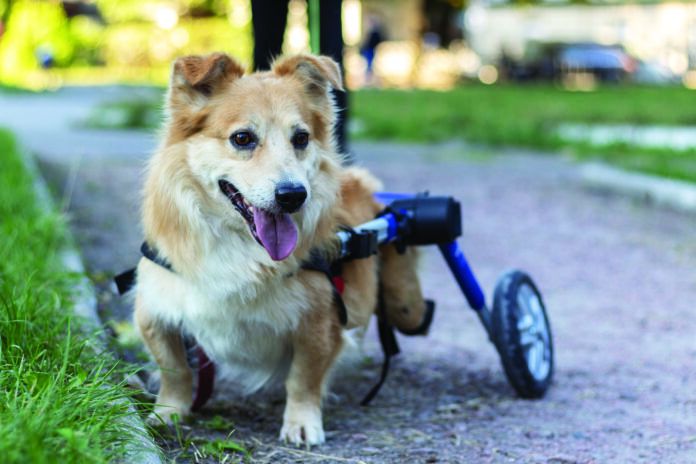
Most of us have seen a dog using a wheelchair to carry his paralyzed or weak back legs. But did you know there are also wheelchairs for dogs who can’t use (or don’t have) front legs? There are even wheelchairs for dogs who can’t walk at all – but with the support of an assistive device to carry most of their weight, are able to get around just fine. Today’s dog wheelchairs enable dogs to walk, run, fetch, and play despite old or new injuries, hip dysplasia, arthritis, leg amputations, degenerative myelopathy, invertebral disc disease, paralysis, or neurological problems that otherwise leave them incapacitated. Thanks to mobility options, dogs who can’t walk on their own don’t have to slow down.
Although they’re called wheelchairs, there is nothing chair-like about these devices. Most canine wheelchairs consist of two wheels (though some have four wheels) and a metal frame that supports the dog’s body.
Types of Dog Wheelchairs
No matter what part of the dog lacks strength or ability, there are wheelchairs that can help:
- Rear-limb wheelchairs. These attach to the dog with a torso or chest harness, and a support bar placed under the abdomen positions the hind legs. If the dog has some hind-leg mobility, being able to touch the ground and move the hind legs aids the dog’s rehabilitation. If not, stirrups can hold the dog’s hind feet up and off the ground. Correctly fitted abdominal support straps or bars help prevent back strain.
- Forelimb wheelchairs. These take advantage of a dog’s strong hind legs while supporting front legs that are weak, missing, or affected by pain by removing the pressure of the dog’s body weight. Some models include a head rest for added support. (See Eddie’s Wheels Forelimb Wheelchairs.)
- Full-body support wheelchairs. These four-wheeled devices help dogs whose front and back legs are weak or partially paralyzed, causing them to stumble when they walk. The wheelchairs make it possible for the dog to move forward without falling. (See the Best Friend Mobility Quad Wheelchair.)
Start With a Veterinary Consultation
To learn whether your dog is a good candidate for a wheelchair, consult your veterinarian or a dog mobility assistance specialist, such as a member of the American Association of Rehabilitation Veterinarians or a graduate of the Canine Rehabilitation Institute.
Some of these experts work directly with companies that make dog wheelchairs and customized mobility carts. They may benefit financially from client purchases, but their assistance can simplify the procedure, improve a wheelchair’s performance, and help resolve problems.
The “towel test” is a simple experiment you can do with your veterinarian or on your own to determine what type of support your dog needs. Place a long towel under your dog’s abdomen and raise your dog’s hips so his feet barely touch the ground. If your dog can move forward using his front legs alone, a rear-support canine wheelchair may work best. If his hind legs are strong but his front legs are weak, he may need a forelimb wheelchair. If your dog stumbles or has trouble moving forward at all, he may need a full-body-support wheelchair.
Checking the FAQs
Most people new to canine wheelchairs want to know:
- Can my dog still use her hind legs in the wheelchair? Yes, if she can move them, whatever exercise your dog can experience will strengthen her body.
- Can my dog still pee and poop while using the wheelchair? Yes, dog wheelchairs are designed to accommodate a dog’s need to eliminate.
- Can the wheelchair go over a curb or stair? Yes, but not long or steep flights of stairs. Installing a ramp can simplify wheeling a few steps up or down.
- How long will it take for my dog to get used to his wheelchair? That depends on your dog and the device. Motivated dogs usually adapt quickly because learning how to use a wheelchair is so rewarding. Allow your dog to adjust at his own pace.
- Can my dog sleep in his wheelchair? Can he stay there all day? The answer to both questions is no. Dog wheelchairs are designed to hold dogs upright, in a standing position, and they are not designed for sleeping or resting. Plan to help your dog out of his wheelchair when it’s time for a nap or at the end of an activity period.
Cost of Dog Wheelchairs
Budget dog wheelchairs cost less than $100, and while they work well for temporary use, such as when a dog is recovering from surgery or an injury, they are not built to last.
In contrast, dogs who need mobility support indefinitely need sturdy, high-quality devices. Midrange canine wheelchairs cost between $100 and $300, and the most durable all-terrain wheelchairs cost up to $850 or more. The most sophisticated wheelchairs combine hoists, mobility wheels, and custom features.
You can find mobility-support devices for dogs on sites like Amazon, but we would strongly suggest buying directly from companies that make their dog wheelchairs. For each of these companies, improving the mobility of impaired dogs is their passion, and they not only provide their customers with detailed information about their products, but also offer encouragement and emotional support to dog owners who have unexpectedly found themselves in the market for one of these devices. And when the product arrives, they can provide phone or emailed help with troubleshooting and adjustment – something you are not going to get from an Amazon reseller.
- Best Friend Mobility. Offers a wide selection of rear support, front support, and quad support devices.
- Doggon’ Wheels. Sells new wheelchairs as well as refurbished products (as available). Doggon’ Wheels also accepts used chairs after families don’t need them anymore and makes them available to needy dogs by request.
- Eddie’s Wheels. Front, rear, and quad support wheelchairs, as well as wheelchairs specially designed for dogs with intervertebral disc disease (IVDD) and degenerative myelopathy.
- K-9 Carts. K-9 Carts makes wheelchairs for dogs – as well as cats and even pet chickens! They also sell a wide variety of other assistive devices for handicapped dogs and offer wheelchair rentals.
- Walkin’ Pets Dog Wheelchairs. Walkin’ Pets claims to have the biggest selection of mobility products for dogs in the world, including wheelchairs and slings, as well as assistive devices for blind dogs and pets with other disabilities.

If you’re handy with tools or have a friend who is, you can build your dog a custom-fitted wheelchair. Here is a good YouTube video that shows you how to make a dog wheelchair.
Tips for Best Results
Each of the founders of the dog-wheelchair companies listed below have a handicapped dog in their past – a dog whose disability sparked their interest in engineering a device that would preserve the dog’s independence and mobility. Each company took a slightly different design tack and has different opinions about what materials work best. But we found the following tips and suggestions reflected in varying but similar forms on each of their websites:
- Have a realistic understanding of what a canine wheelchair can and cannot do for your dog. Advice from your veterinarian or a canine rehabilitation therapist can help you decide whether and how to proceed.
- Consider your own involvement, for your dog will need help getting into and out of a wheelchair, you’ll have to help your dog learn to use it, and you’ll need to be with your dog when she’s out and about.
- Study different brands and styles to compare their features, warranties, customer support, and reviews. Take your time deciding which model to try. Impulse purchases are not recommended here.
- Compare features, such as how easily a wheelchair folds for storage, what accessories it features, and how easy it is to adjust for a better fit.
- Choose a wheelchair that will be the right size, with a frame strong enough to support your dog but not too heavy for your dog to pull. Pay attention to tire size. Small tires aid maneuverability in tight spaces, but large tires are better for navigating rough terrain, which matters if you plan to hike with your dog. Air-filled tires provide a smoother ride but solid rubber tires can’t be punctured.
- Take accurate measurements. This point can’t be overemphasized because success depends on a comfortable fit. Most wheelchair websites give detailed instructions for measuring your dog.
- Learn what’s involved in receiving your dog’s wheelchair. Some assembly will be required, and you’ll have directions to follow. Be ready to report any missing hardware or assembly problems, and study manufacturers’ websites to see what support they provide, such as video consultations, phone chats, or other methods of answering questions and improving the wheelchair’s performance.
When is the right time to order a chair?
It’s never too early to learn about dog wheelchairs by visiting websites, watching videos, and reading reports so that if your dog needs assistance, you’ll be able to make informed decisions. If your dog’s mobility problems are likely to increase, most experts suggest investing in a wheelchair sooner rather than later, so that the transition to this mode of transportation is less stressful than if you wait for your dog to be incapacitated.





